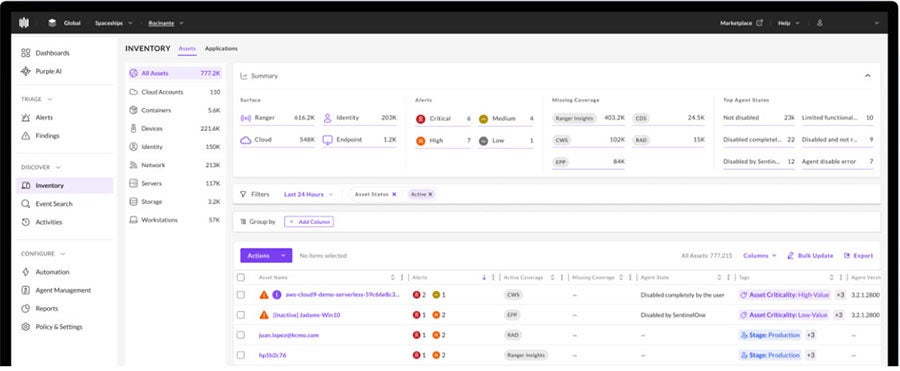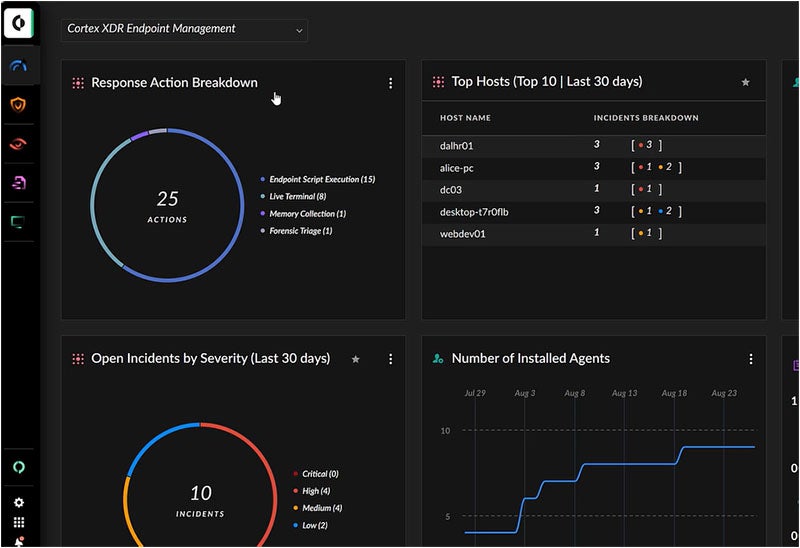
Perhaps you’re looking for an endpoint detection and response tool to enhance your cybersecurity efforts. SentinelOne and Palo Alto are two of the top brands in this space, and this comparison will help you decide if either one of the company’s tools is right for you.
SentinelOne’s Singularity XDR platform offers EDR and more with its end-to-end protection, visibility and response capabilities. The product also provides hassle-free integrations with other tools a company may already use.
Cortex XDR is Palo Alto Networks’ EDR offering. It aids cybersecurity teams before and after attacks happen, helping them mitigate the effects of such incidents and reduce the chances of similar events happening in the future.
| Starting Price | ||
| Artificial intelligence-based threat detection | ||
| One-click remediation and rollback | ||
| USB protection | ||
| Managed threat-hunting service | ||
| Scope-based access control | ||
| Demo available | ||
|
|
SentinelOne’s Singularity platform offers four subscription tiers that include their EDR service. All the prices below reflect pricing for 5-100 workstations.
Here is a breakdown of each:
Fortunately, you can request a demo of both Singularity Commercial and Singularity Enterprise via SentinelOne’s official website.
For Palo Alto’s Cortex XDR service, we get two tiers: Cortex XDR Prevent and Cortex XDR Pro.
Endpoint protection is present in both, but XDR Pro includes detection and response and the option for forensics, managed detection and response and host insights.
SEE: Brute Force and Dictionary Attacks: A Guide for IT Leaders (TechRepublic Premium)
While you can request a demo of Cortex XDR on Palo Alto’s official website, there is no explicit price list of both Cortex XDR tiers as of May 2024.
Personally, I would’ve liked to see more transparent pricing from Palo Alto to get a better understanding of Cortex XDR’s value proposition. But you can contact them for both a demo and a price quote for their EDR and XDR services.
Since so many of today’s cybersecurity teams deal with ever-increasing workloads, they typically like automated features that help them find and resolve threats faster. Both of these tools have plenty to offer in that regard.
SentinelOne’s Singularity XDR has an automated Storyline feature that automatically links events and associated activities together, helping cybersecurity experts learn what happened and when. This feature allows people to see the context of events in seconds rather than potentially taking hours to draw those connections manually. It also assigns a risk score to each event, letting teams triage and prioritize it.
SentinelOne’s automation capabilities also extend to artificial intelligence (AI) models residing on each device in a network. They detect unusual activity in real time and even allow the devices to self-heal after an attack, which significantly reduces the labor required by a company’s cybersecurity experts.
Palo Alto’s automation for Cortex XDR extends customizable features and automation packs that help companies start streamlining processes faster. In addition, the tool uses machine learning, including behavioral analytics, to automatically detect threats and alert people to them.
Cortex XDR can automatically integrate host data with network and flow logs, making it easier to pinpoint the root cause of a threat. The platform also automatically groups related threats, helping users decide which threats need attention first.
SentinelOne recently introduced new PowerQuery analytics features that allow users to search through and summarize data without working with it manually. The company suggests this functionality will be a substantial time-saver for tasks like hunting for ransomware or locating top threat indicators by endpoint.
SEE: SentinelOne vs CrowdStrike: Compare EDR Software (TechRepublic)
By comparison, Cortex XDR aims to reduce the alert fatigue often associated with data analysis by letting people only receive notifications about the events that matter most to them. Then, when it’s time to analyze what happened, everything can take place from within a single location. Seeing all the necessary information at once lets people act quicker and with more confidence. The platform also has real-time data analytics capabilities courtesy of the Analytics Engine feature.
The SentinelOne dashboard allows users to create custom detection rules against certain threats. They’ll then get alerted when network activity matches those parameters. Moreover, the program recognizes and responds to a full assortment of queries that help analysts work with the data and draw educated conclusions.
SentinelOne also retains data for a year, making it easier for users to perform historical analyses and see if current threats have caused problems before.
Similarly, Palo Alto lets people create customizable dashboards that reflect the needs of their organizations. It’s possible to summarize security events and larger trends with graphical reports that people can make on-demand or at scheduled intervals.

The dashboard also shows open incidents across time. That information can help cybersecurity leaders better manage their labor forces and workflows.
Both SentinelOne and Palo Alto Cortex XDR are highly rated EDR solutions, offering useful documentation to help users learn the platform more effectively.
While Cortex XDR is preferred for its ease of use and ongoing product support over SentinelOne, the platform requires more configuration to work well, especially for in-house and custom software. Users also tend to prefer SentinelOne’s new feature rollouts and its ability to cover mobile device security. As such, SentinelOne is ideal for smaller teams in need of a robust EDR solution that will also allow them to meet their business needs.
SEE: Check Point vs Palo Alto: Compare EDR Software (TechRepublic)
However, when choosing an EDR solution, it is important to consider why you need it and how the top features of the solution can help improve your business’s efficiency and security. If you’re still unsure, both SentinelOne and Palo Alto offer free demos, which can allow you to get acquainted with what’s available and envision how these products could address your organization’s pain points.
My comparison between SentinelOne and Palo Alto’s respective EDR solutions involved a detailed assessment of each product’s security offerings, cost and standout features.
I took into consideration both providers’ EDR capabilities, such as automation, analytics, remediation and threat detection, among others. This was done via thorough research of both products’ official documentation and feature inclusions.
In addition, I also accounted for real-user feedback found on reputable review sites as a means to round out advantages and disadvantages of both solutions.